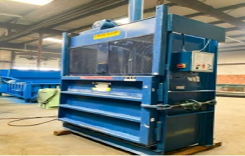If you have ever worked on a farm or in a recycling plant, the chances are very high that you are familiar with baling wire. Baling wire is strong and flexible and is looped at one end. It is used for securing bales of waste or hay so that they do not disintegrate during travel or stacking. Such a utilitarian item is often used, but very rarely is its manufacture considered by the people using it. Here then, is a quick guide to the production process behind the bendy, fiddly and always-useful baling wire.
The Raw Material
To make a good product, you have to start with the right ingredients. The most baling wire starts life off as a carbon steel rod. Carbon steel, as the name might suggest, is a steel that contains high levels of carbon. As a rule of thumb, the more carbon an alloy contains, the stronger it will be. The balance has to be right though. Increased carbon in steel will make the metal harder to work with. Baling wire manufacturers need to carefully calibrate their equipment to match the amount of carbon in their source material.
Drawing
The raw material is then drawn in order to produce the wire itself. In the drawing process, the alloy is pulled through a series of progressively small dies made of diamond or tungsten. This slowly thins and stretches the wire into the desired thickness. It is a very demanding process and requires powerful and finely tuned machines. Most wire manufacturers will need to draw their wire several times before it is ready for strengthening.
Galvanization
The highest quality baling wires are galvanized for strength. This process is undertaken after drawing and before looping. It involved the coating of the newly drawn wire in a layer of molten zinc. Galvanization helps to prevent oxidization and allows for use in wet conditions and contact with non-ferrous metals.
Annealing
For wire that will be used in less demanding applications, annealing is used instead of galvanization. The annealing process involves heating and cooling the newly drawn wire rapidly, allowing it to be stretched further and giving it great flexibility. Annealed wire is great, but it rusts when exposed to moisture and should not be used for long-term baling and storage. Companies like balingwiredirect.com offer both galvanized and annealed wire to suit different applications.
Looping
One of the defining features of baling wire is the little loop wound into one end. This loop allows workers to use baling machines to securely tie the wire around the waste or hay that they are securing. Looping is one of the last stages of the baling wire manufacturing process and is achieved using a machine that pinches and then spins the wire, creating an eyelet.
Packing
Finally, the wire is packed into spools, which are then distributed. Spooling is by far the most efficient way of storing wire. Manufacturers usually sell the product wholesale, but have, on occasion sold directly to the end-user.





